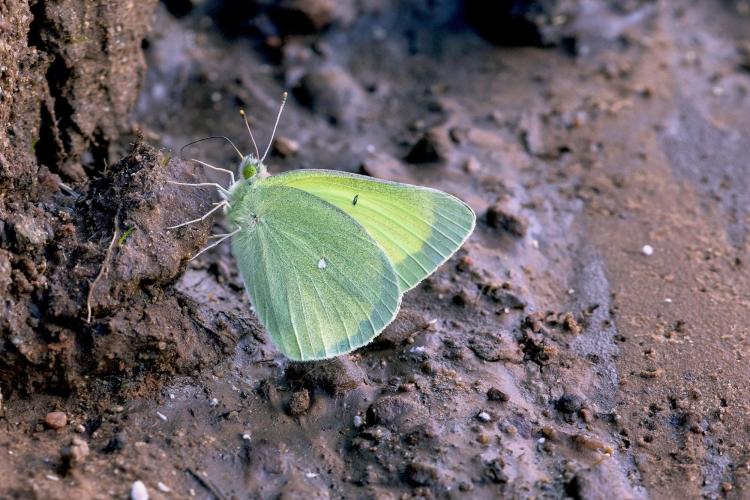Queen Alexandra’s sulphur an ultraviolet marvel
Butterfly species is fascinating when it comes to color variation
During my annual trip to the Uncompahgre Plateau in western Colorado, I always visit Big Creek to watch puddling butterflies. This time Queen Alexandra’s sulphur, Colias alexandra, (C. alexandra) was abundant so I was able to identify males and females by color patterns.
This species is fascinating when it comes to color variation, for it has four separate systems or modes of color variation: differences between genders, variation in pigmentation (melanization) with elevation, a distinct color polymorphism (limited to females) and patterns in the ultraviolet range (limited to males).

A Queen Alexandra’s sulphur inserts her long proboscis into the mud to sip water, minerals and nutrients. This species is fascinating when it comes to color variation, for it has four separate systems or modes of color variation. Photo by Jeff Mitton.
The upper, or dorsal, sides of male wings are glossy yellow with dark margins, while females have light yellow with margins that are thinner and muted. The genders have similar colors and patterns on the lower, or ventral, sides. Forewings are yellow near the base with light green margins and a dark ellipsoid with a white center near the leading edge. The ventral side of the hind wing is frosty green with darker green margins and a white spot near the center.
While the undersides of the insect’s wings are predominantly green, in some populations grey or brown scales darken the basal portions of the hind wings. Males and females from the same locality have the same degree of darkening, or melanization, but it differs among localities, with most of the variation being associated with elevation. C. alexandra from low elevations usually have no discernible melanization, while the darkest insects are found at high elevations.
This is functional or adaptive variation, as shown by behavior of butterflies on chilly mornings when they must bask in sunlight to gain sufficient warmth to fly. At these times, they orient at right angles to the sunlight, so they can intercept the maximum amount of heat possible. In contrast, on warm to hot days, they sit with their wings aligned in the direction of the sunlight to avoid getting warmer.
Melanization is greatest on the basal portions of the hind wings, adjacent to the abdomen and the thorax, where it is best positioned to warm up flight muscles that are too cold to fly. When butterfly body temperatures were recorded during basking, darker butterflies heated up faster and reached higher internal temperatures.
The same pattern was found when body temperatures of dead butterflies were compared, so the temperature gain is due to melanization but not to behavior or physiology. Similar temperature differentials between light and dark individuals have been reported in other insects, pine cones and marine mussels. The same principle makes black cars hotter than white cars in bright sunlight.
The alba phenotype, determined by a single gene expressed only in females, has completely white wings. The alba gene diverts metabolic precursors of pteridine pigments to other metabolic pathways, reducing wing pigmentation to nil. However, the diverted nitrogen-rich metabolites enhance growth of larvae and allow alba individuals to carry greater amounts of fat into the adult stage. Superior growth rates and having more fat in early adulthood are advantages that make alba phenotypes more common in cold environments.
Alba females have disadvantages as well. They lay fewer eggs than pigmented females and males prefer pigmented over alba females by a factor of 5-to-1. In addition, alba females heat up more slowly than pigmented females, so on chilly mornings they need to spend more time basking in the sun, leaving less time for other tasks.
Males, but not females, exhibit color variation in the ultraviolet range. Humans cannot see UV light without special lights and filters, but those wavelengths are apparent to butterflies. Wing scales with micro-structural layers that reflect UV light produce the UV patterns.
Experiments in other butterfly species have shown that females prefer to mate with males with the brightest UV pattern, but regrettably, similar mating studies have not been conducted in C. alexandra. Nine subspecies of C. alexandra have been described, and each has a different UV pattern.
Color differences between genders and UV patterns make it easier for females and males to make correct identifications, for both species and genders, while courting. Melanization and alba phenotypes both increase adaptation to the colder temperatures at higher elevations. At first glance, the color variation in Queen Alexandra’s sulphur may appear frivolous and irrelevant, but careful studies show that it all matters.

